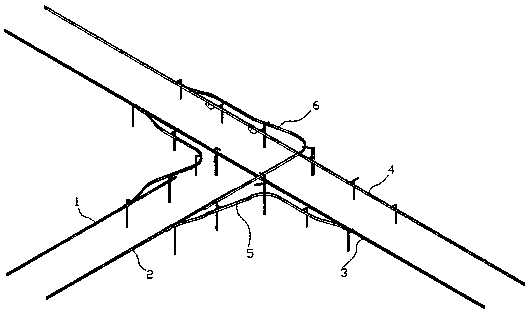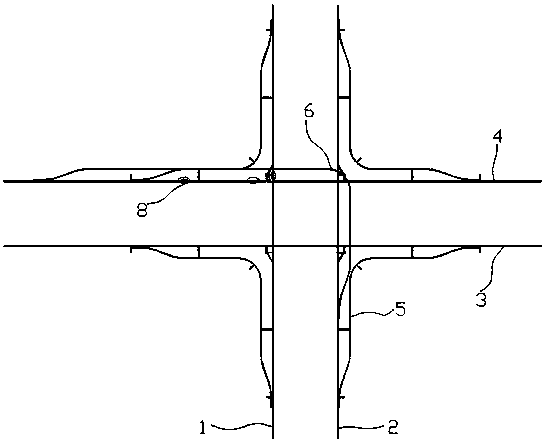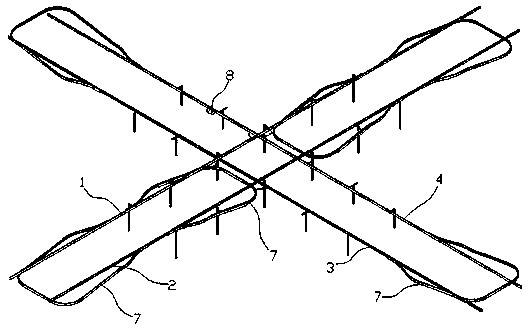Interchange system for suspended rail traffic intersection
A rail transit and suspension technology, applied in the field of transportation, can solve the problems of inflexible steering and multiple congestion of rail transit such as subways, and achieve the effects of improving traffic capacity, saving time and flexible routes.
- Summary
- Abstract
- Description
- Claims
- Application Information
AI Technical Summary
Problems solved by technology
Method used
Image
Examples
Embodiment 1
[0023] Such as figure 1 and figure 2 The suspension-type rail transit intersection steering system shown includes a first main track and a second main track that are different in height and direction, and the first main track and the second main track are staggered to form an intersection, such as: a three-way intersection (such as figure 1 shown) or intersections (such as figure 2 shown), the first main track and the second main track are connected by a turning track, so that the rail car 8 on the first main track can enter the second main track through the turning track, or the rail car on the second main track can turn Entering the first main track, there are no traffic lights during the whole turning process, no need to wait, which saves time. Preferably, there are two first main tracks, which are the first main track 1 on the left side and the first main track 2 on the right side, which are used for rail cars 8 traveling in reverse on both sides in the direction of th...
Embodiment 2
[0028] Such as image 3 The overhead suspension rail transit system of the U-turn function shown includes two first main rails in the same direction, the first main rail on the left side and the first main rail on the right side 2. Between the two first main rails It is connected by a U-shaped U-turn track 7 . In another direction, there are also two second main tracks on the left side, the second main track 3 and the second main track 4 on the right side. The two second main tracks are connected by another U-turn track 7, and the first main track Different from the height of the second main track, the first main track and the second main track are staggered to form an intersection, and the U-turn track 7 is located in front and / or behind the intersection. When there are U-turn tracks before and after the crossing, rail car 8 can turn around in front of the crossing, and can also turn around in the rear of the crossing. The height difference between the first main track and ...
Embodiment 3
[0030] Such as Figure 4 and Figure 5The shown suspended rail transit intersection system includes the suspended rail transit steering system in Embodiment 1 and the suspended rail transit U-turn system in Embodiment 2. There are no traffic lights in the overhead suspension interchange system, and it can not only meet the U-turn and steering of rail cars in the system, but also increase the turning route. For example, in the area driving on the right, the rail car on the first main track on the right will When turning, you can turn left directly into the second main track on the right through the left-turning track. If there are many vehicles in front, you can first enter the second main track on the left through the right-turning track, and then pass through the second main track between the two second main tracks. Turn left on the U-turn track onto the second main track on the right. At an intersection, a rail car that needs to turn left can even turn left by turning righ...
PUM
 Login to View More
Login to View More Abstract
Description
Claims
Application Information
 Login to View More
Login to View More - R&D Engineer
- R&D Manager
- IP Professional
- Industry Leading Data Capabilities
- Powerful AI technology
- Patent DNA Extraction
Browse by: Latest US Patents, China's latest patents, Technical Efficacy Thesaurus, Application Domain, Technology Topic, Popular Technical Reports.
© 2024 PatSnap. All rights reserved.Legal|Privacy policy|Modern Slavery Act Transparency Statement|Sitemap|About US| Contact US: help@patsnap.com










